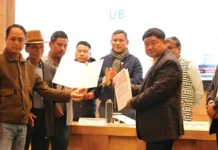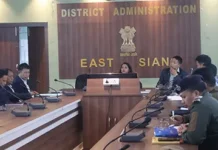ITANAGAR, 20 Dec: A group of more than 450 experts, scientists, community representatives, and environmental groups from across the country and abroad, especially the Himalayan states, have appealed to President Droupadi Murmu to withdraw the paramilitary forces deployed in Siang Valley to ‘forcefully’ carry out hydropower project surveys.
“We are utterly disturbed and deeply concerned with the recent news about governmental orders for deployment of paramilitary troops in the Siang Valley for conduct of a pre-feasibility survey for the 11000 mw (11 gigawatt) Siang upper multipurpose project (SUMP),” they said in a joint representation to the president.
They informed the president that the proposed SUMP would be India’s largest hydropower project and has been a raging controversy in the state for years, given the opposition of the local indigenous population of the Adi tribe inhabiting one of India’s most important Himalayan biodiversity hotspots.
They said that the local tribal agitations stem from the potential threat to the ecology, geology and socio-cultural environment as a result of hydropower project of such a large magnitude and scale.
Expressing solidarity with the Siang Indigenous Farmers Forum (SIFF), which has been spearheading democratic protests against the construction of the mega dam, the representation said: “It is disturbing that the state government has turned around on its own promise made a few months ago that no activity of the project shall be initiated without the consent of the people.”
“Not long ago, the Rajya Sabha was informed that local villagers had raised concerns over the SUMP. The power minister said that these concerns are being addressed through confidence-building measures and outreach activities,” the representation read.
“Even the prime minister and the home minister told people of the state in the past that if they do not want big dams, they won’t build any big dams as there are many options for electricity generation and development,” it said.
It further said that sufficient evidence already exists about the hazardous nature of these hydropower dams which are no less than ticking time bombs in the Himalayas.
“The apprehensions of the indigenous populations of the Siang Valley are not merely fears but based on real threats to survival, safety and security of the local inhabitants and communities living downstream in the valley.”
“In the past few years many parts of the western Himalayas have seen an unprecedented rise in the frequency and intensity of climatic events like floods, glacial lake bursts, cloudbursts, landslides, sinking land and avalanches,” it said.
It said that the 2013 Uttarakhand floods led to the death of over 5,000 people officially and caused damage to multiple hydro projects.
“In 2021, an avalanche in Chamoli caused catastrophic floods that destroyed hydropower infrastructure and claimed over 200 lives. In 2023, the Teesta III dam was destroyed by a glacial lake outburst in Sikkim. And this year in Himachal Pradesh, the Malana dam burst as it was hit by a sudden flood from upstream,” the representation read.
In all these events, not just hydropower infrastructure worth hundreds of crores of rupees was completely destroyed, public infrastructures and private properties, including houses, farms and fields at downstream of the dam were swept away, they said.
They also said that flood- and landslides-related casualties are also on the rise in the Himalayan region in the past few years, and that these events are increasing the disaster potential of the region as shown by numerous scientific studies.
“A recent study titled ‘Landslide Hazard Is Projected to Increase Across High Mountain Asia,’ was conducted by NASA’s Goddard Space Flight Centre and projects over 30% increase in landslide hazards by the end of the century compared to baseline levels recorded between 1990 and 2014. The areas around and downstream of dams are the most vulnerable to these landslides and subsidence due to slope destabilisation by blasting and excavation.”
They said that the people of the Siang Valley are well aware of the sensitivity of their landscape, the rapidly changing unpredictable climatic conditions and the possible hazards associated with such massive constructions in this topography.
“This indigenous knowledge and consciousness, which our government has emphasised in all its plans and programmes, need to be paid heed to at this very hour.”
“Further, there is a serious need for India to review its hydropower plans in the Himalaya as river discharges reduce leading to a drop in the hydropower generation for a large part of the year. Entities like the NHPC have repeatedly failed in timely commissioning of mega projects due to the above said challenges.”
“This is also exemplified in what is happening at the under-construction 2,000 MW Subansiri Lower Hydropower Project on Assam-Arunachal Pradesh border. Siang Valley has itself seen multiple cases oflandslides, earthquakes, flashfloods, breach of landslide dams, etc, in the recent years as also in the past, underlining the inherent disaster prone nature of the area.”
“One of the reasons that the people have been opposing the initial surveys is because once a survey of such a large scale project is underway it compromises the stance of the local people as project proponents cite investments in surveys as an excuse for approvals.”
“India is a signatory to conventions and climate treaties that pledge to protect not just rights of the indigenous people and their livelihoods but also the biodiversity and ecosystems that they depend on for survival and which play the role of maintaining ecological balance.
“Siang district is known for its rich biodiversity, particularly within the Dihang-Dibang biosphere reserve which spans across West Siang, Upper Siang, and Dibang Valley, making it one of the most biodiverse areas in the state with a wide variety of flora and fauna, including many endemic species; this region is considered a biodiversity hotspot globally.
“The UN Declaration on the Rights of Indigenous Peoples, to which India is a signatory, gives indigenous people the right to give or withhold consent on any activities impacting their lands, resources, livelihoods and health,” the representation said.
It further stated that the SIFF had filed a case in the high court, challenging the Siang ultra mega power plant, and that in September, 2022 “the Arunachal Pradesh High Court also directed that the consent of the people be upheld.”
“Initiating any surveys without the consent of the local village councils is also a violation of constitutional statutes, especially Section 5 of the Scheduled Tribes and Other Traditional Forest Dwellers (Recognition of Forest Rights) Act 2006.
“It is imperative that the trust and faith of the local indigenous population in the constitutional democracy be maintained through use of democratic consultations and processes of free prior informed consent of the gram sabhas. In the long run there is no other option but to review India’s hydropower plans in the region in the interest of the ecology, economy and citizens’ security. We need care, caution, respect and informed participatory decision making and not imposition of projects using force in the name of development,” it added.
Some of the signatories were Narmada Bachao Andolan, Titli Trust, Save Siang Valley, Siang Indigenous Farmers’ Forum, Abor Valley Pvt Ldt, Aanwg Anya Foundation, All Adi Welfare Society, All Hari Students’ Union, AP Queerstation, Bangalore-based Ashoka Trust for Research in Ecology and Environment, Friends of Ladakh, Friends of Nature, and Youth for Himalaya.



